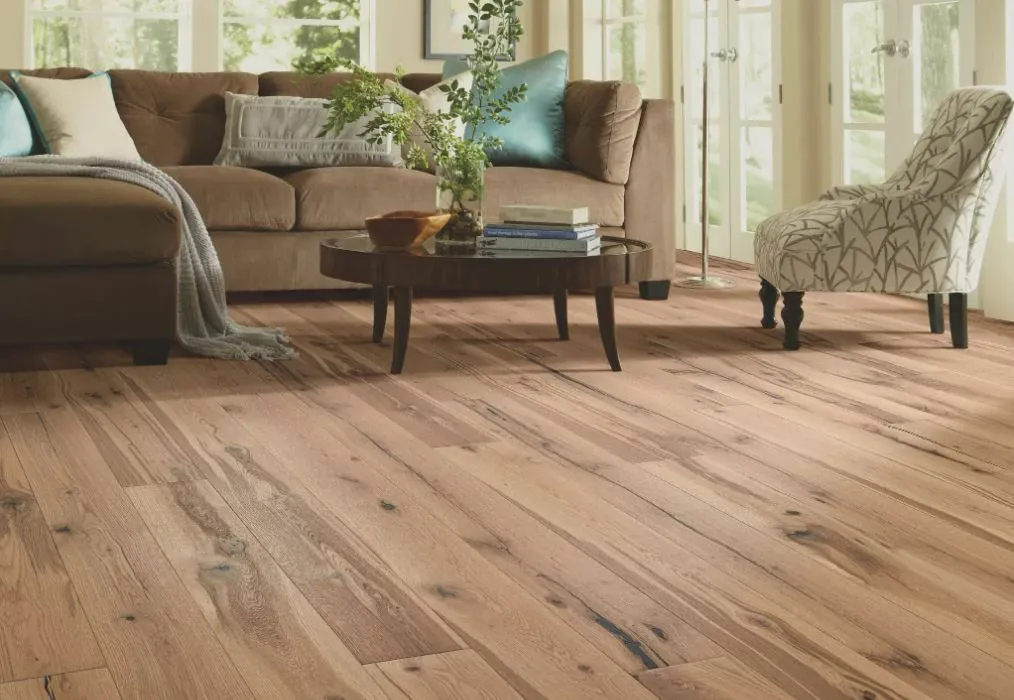Hardwood flooring is a popular choice for homeowners due to its durability, beauty, and timeless appeal. However, the production and installation of hardwood flooring can have a significant impact on the environment. Deforestation and carbon emissions are just some of the negative consequences associated with conventional hardwood flooring options.
Despite this, there are eco-friendly and sustainable options available for those who want to minimize their environmental footprint while still enjoying the benefits of hardwood flooring. From reclaimed wood to certified sustainable wood and alternative materials, consumers have more choices than ever before when it comes to selecting an eco-conscious option for their home.
In this article, we will explore these various options in depth to help you make an informed decision about which one is right for your needs.
Reclaimed Wood
Reclaimed wood, which involves repurposing salvaged wood for use in flooring, presents a viable eco-friendly and sustainable option for hardwood flooring.
This process involves taking old wooden beams, planks, or other structures that would otherwise be discarded and transforming them into beautiful new flooring options.
Not only does this method reduce waste and preserve natural resources, but it also adds character to the finished product as each piece of reclaimed wood has its own unique history.
Reclaimed wood also has the added benefit of being often more durable than newly sourced hardwoods due to its age and density.
The older the wood is, the tighter its grain becomes making it harder and stronger. Additionally, using reclaimed wood can help reduce deforestation since there is no need to cut down additional trees in order to produce new flooring materials.
Overall, choosing reclaimed wood for your flooring needs not only benefits the environment but also adds a touch of history and uniqueness to your home’s interior design.
Certified Sustainable Wood
One solution to ensure the responsible use of wood resources is through certification programs, such as the Forest Stewardship Council (FSC), which promotes sustainable forest management practices. FSC-certified wood ensures that forests are managed in a way that maintains biodiversity, productivity, and ecological processes while also meeting the needs of local communities and supporting economic viability. These standards go beyond environmental concerns to include social and economic considerations for workers and communities.
For example, a case study conducted by FSC found that an indigenous community in Brazil was able to enhance their economic and social well-being while preserving their local ecosystem through certified sustainable wood harvesting for flooring production. The community was able to diversify its income sources by selling sustainably harvested timber while still maintaining traditional hunting, fishing, and agricultural practices. This not only provided an alternative source of income but also helped maintain cultural traditions and strengthen community ties.
By choosing FSC-certified wood for hardwood flooring, consumers can support these types of sustainable practices while enjoying beautiful and durable floors.
Alternative Materials
Bamboo flooring is a popular choice for its durability and sustainability, as it is a fast-growing grass that regenerates quickly.
Cork flooring is also eco-friendly and provides cushioning underfoot, but may require more maintenance than other options.
Linoleum flooring is made from natural materials such as linseed oil and cork powder, making it another sustainable option with a range of design choices.
Bamboo Flooring
Bamboo flooring is a rapidly renewable and sustainable option for hardwood flooring, as it matures faster than traditional hardwoods and requires less water and pesticides to grow. Bamboo plants can mature in approximately 5 years, while most hardwood trees take decades to reach maturity. Moreover, bamboo plants require much less water than traditional hardwood trees, making them ideal for areas with limited water resources.
Additionally, because bamboo is naturally resistant to pests and diseases, farmers do not need to use harmful pesticides during the growing process. In terms of performance and durability, bamboo flooring is comparable to many traditional hardwoods. It is hard-wearing and scratch-resistant, making it an excellent choice for high-traffic areas such as hallways or living rooms.
Furthermore, bamboo flooring has a unique texture that adds visual interest to any space where it’s installed. With its eco-friendliness combined with its aesthetic appeal and durability, it’s no wonder why more people are choosing bamboo flooring as an alternative to traditional hardwood floors.
Cork Flooring
Cork flooring has revolutionized the flooring industry with its unparalleled ability to absorb sound and provide a comfortable walking surface. This eco-friendly alternative to hardwood flooring is made from the bark of cork oak trees, which naturally regenerate every nine years.
Here are three reasons why cork flooring should be considered for your next home renovation project:
1. Durability: Cork is a highly durable material that can withstand high foot traffic without showing wear and tear. It also has natural anti-microbial properties that make it resistant to mold, mildew, and insects.
2. Sustainability: Cork is an incredibly sustainable material because it comes from a renewable source – the cork oak tree – that does not require cutting down the tree itself. Instead, only the bark is harvested, leaving the tree intact and able to regenerate new bark every nine years.
3. Comfort: Cork provides a soft and cushioned surface underfoot that makes it ideal for homes with children or pets. It also has excellent thermal insulation properties, which means it can help keep your home warm during winter months while keeping cool air inside during summer months.
Linoleum Flooring
Linoleum flooring has been a popular choice for commercial and residential spaces due to its versatility, affordability, and easy maintenance. It is made from natural materials such as linseed oil, cork flour, wood flour, limestone dust, and pigments. These materials are renewable and biodegradable which means that linoleum flooring is an eco-friendly option for homeowners who want to reduce their carbon footprint.
Moreover, linoleum flooring is highly durable and can last up to 40 years with proper care. It is resistant to scratches, stains, and water damage which makes it a practical choice for high traffic areas like kitchens or hallways. Additionally, it comes in a wide range of colors and patterns which allows homeowners to customize their floors according to their personal style preferences.
Overall, linoleum flooring offers an affordable yet sustainable alternative to hardwood floors that can enhance the aesthetic appeal of any space while minimizing environmental impact.
Pros and Cons of Alternative Materials
Among the numerous materials that can be used as flooring, some have unique advantages and disadvantages worth considering. When it comes to eco-friendly or sustainable options for hardwood flooring, there are a few materials that stand out. These include bamboo, cork, reclaimed wood, and engineered wood.
1. Bamboo is a popular choice as it is fast-growing and easily renewable.
2. Cork has natural insulation properties and is harvested from the bark of cork oak trees without harming them.
3. Reclaimed wood involves using salvaged wood from old buildings or structures, reducing waste and preserving historical elements.
4. Engineered wood combines a thin layer of real hardwood with plywood or high-density fiberboard, making better use of resources than solid hardwood.
While these alternative materials may not offer the same aesthetic appeal as traditional hardwood, they do provide environmentally-friendly options for those looking to reduce their carbon footprint or preserve natural resources. It’s important to weigh the pros and cons of each material before making a decision on what type of flooring to install in your home or commercial space.
Frequently Asked Questions
How does using reclaimed wood for flooring contribute to sustainability?
Using reclaimed wood for flooring contributes to sustainability by reducing the demand for new hardwood and diverting waste from landfills. This process also preserves the unique characteristics of old-growth forests while reducing deforestation and carbon emissions associated with logging and transportation.
What is the difference between FSC-certified wood and other sustainable wood certifications?
FSC-certified wood is characterized by the strict standards of the Forest Stewardship Council, which includes environmental and social criteria for responsible forest management. Other sustainable certifications may differ in their specific requirements but share similar goals of promoting sustainable practices in the industry.
Are there any alternative materials for hardwood flooring that are completely eco-friendly?
Bamboo, cork, and reclaimed wood are eco-friendly alternatives to hardwood flooring. These materials have a lower environmental impact due to their fast growth rate, ability to regenerate, and use of recycled materials.
Is it possible to find sustainable hardwood flooring options in a variety of colors and styles?
Various sustainable hardwood flooring options are available in a range of colors and styles. These include reclaimed wood, bamboo, cork, and certified sustainably harvested hardwoods. Each has unique characteristics that can suit different design preferences while reducing environmental impact.
How do the costs of eco-friendly hardwood flooring options compare to traditional hardwood flooring?
The cost of eco-friendly hardwood flooring options varies depending on the type of wood, finish, and installation. Some may be more expensive than traditional hardwood flooring, but long-term savings can be achieved through energy efficiency and reduced environmental impact.
Conclusion
In conclusion, the quest for eco-friendly and sustainable hardwood flooring has led to the emergence of various options.
Reclaimed wood is one such option that involves salvaging wood from old buildings, bridges, and other structures. This approach not only reduces deforestation but also promotes recycling and reusing resources.
Another option is certified sustainable wood, which is harvested from well-managed forests that follow strict environmental standards.
Furthermore, alternative materials like bamboo and cork are becoming popular choices for those seeking eco-friendly flooring solutions. Bamboo grows quickly and requires less water compared to traditional hardwood trees while cork can be harvested without damaging the tree itself.
However, it is important to note that each of these options has its unique benefits and limitations depending on factors such as cost, durability, and maintenance requirements.



